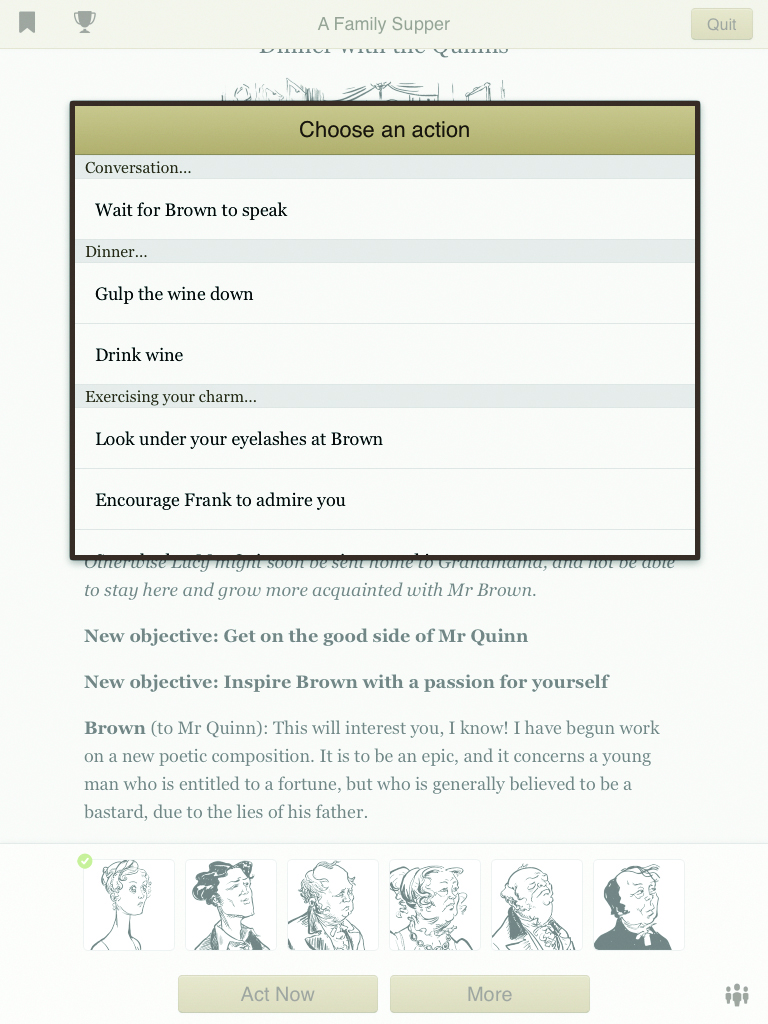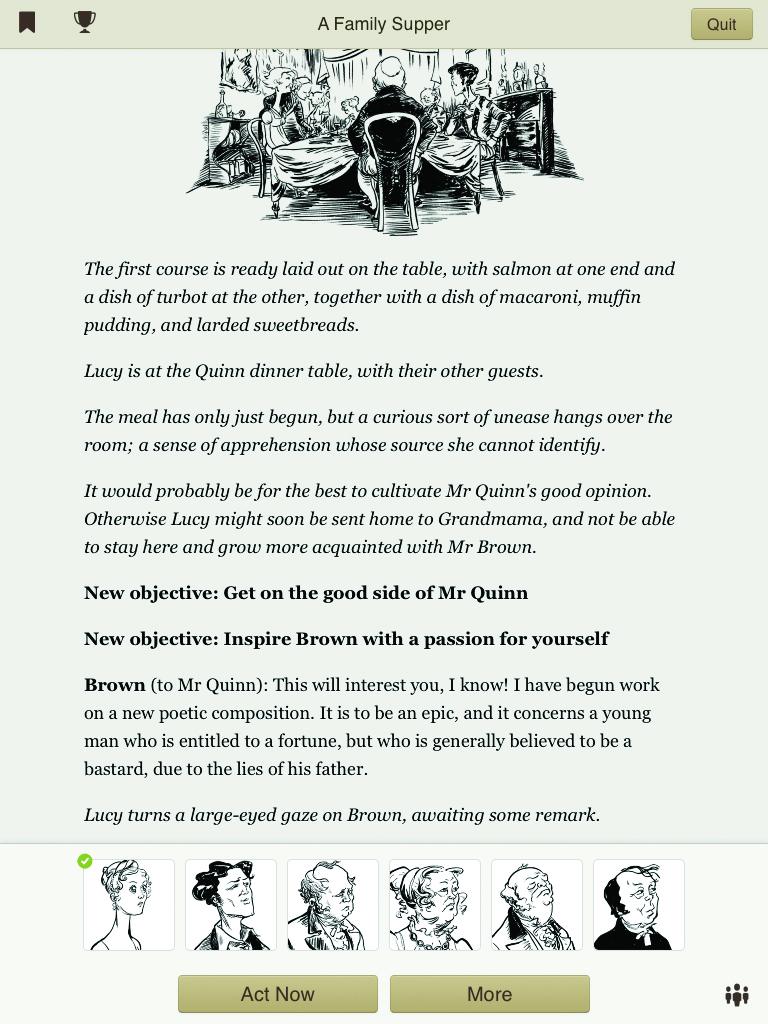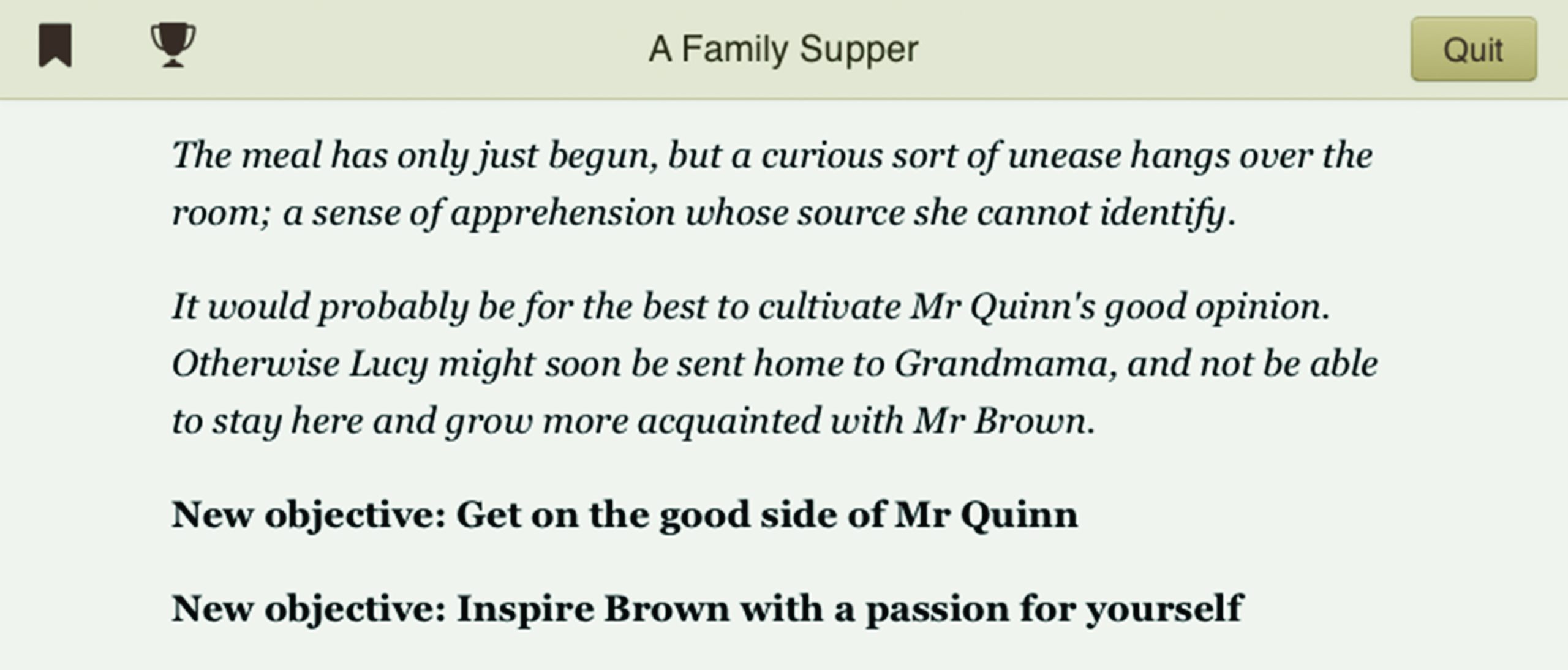[I]t was as if the phrases he had in front of him had become suddenly familiar, were starting irresistibly to remind him of something, as if on to each one that he read there had been imposed, or rather superimposed, the at once precise yet blurred memory of a phrase almost identical to it that he had perhaps already read somewhere else… — Georges Perec, “The Winter Journey.”
Rereading a text can often call to mind echoes of previous readings, and at the same time create a feeling that something has altered or become distorted in the process of translating between the first and subsequent readings. This essay investigates how this notion of rereading as echo is both more pronounced and at the same time different in interactive stories, where readers rarely engage in a single reading and yet where each subsequent reading may, literally, be different from the previous readings.
We begin by discussing how critics and literary theorists have characterised the act of rereading, and look briefly at how researchers in the area of interactive storytelling have approached this process. We then introduce a model for how, and why, people reread in interactive stories. We explore the implications of our model through a close (re)reading of “A Family Supper” by Emily Short, discussing how the work initially encourages rereading for closure, but eventually frustrates attempts at further rereading beyond closure. This suggests that rereading in interactive stories, like an echo, can initially sustain interest but that this interest dissipates as the original, narrative motivation for reading is lost and readers begin to ‘play’ with the text to see how the form of the story can be distorted and broken. The challenge for authors of interactive stories is to discover ways in which this form can encourage the type of sustained, long-term interest in revisiting the story that keeps people coming back to re-experience traditional, non-interactive stories.
What is rereading?
Rereading has long been seen as an important way to distinguish a work of literature from other texts. As C. S. Lewis claims, a book can be seen as having lasting value if there is even one reader for whom that book has “been a lifelong delight, who had read and reread it, who would notice, and object, if even a single word were changed” (Lewis, 1961: 108). It is not so clear, however, what a reader is actually doing when rereading, and how rereading relates to reading.
When a reader reads a text a second time the reader already knows what is coming. This can change the experience and also the motivations for reading, since “during the process of reading, there is an active interweaving of anticipation and retrospection, which on a second reading may turn into a kind of advance retrospection” (Iser, 1980: 282). As a result, what a reader is looking for and experiencing on a second or subsequent reading can be very different from the original reading. What the reader may be looking for is not clear. According to Leitch, “[r]ereading is never simply rereading: it is always reading for something, reading from a new point of view, with new presuppositions, motives, and requirements” (Leitch, 1987: 507). In contrast, Barthes feels that a second reader is looking “to multiply the signifiers, not to reach some ultimate signified” (Barthes, 1974: 165). This suggests a need for subsequent readings to add to our experience, rather than simple recreate it. Brooks highlights the problems this creates, arguing, “unless the work gains in irony for each loss in mere mystery, second readings will be disappointing” (Booth, 1961: 285).
Despite these difficulties with the concept of rereading, there have been a number of attempts to categorise the ways in which people reread stories. Calinescu (1993) has identified three types of rereading: partial rereading, where the reader has not full comprehended or appreciated the text; simple rereading, where the reader rereads to recapture the experience of the first reading; and reflective rereading, where the reader returns to the text to look for something more—for example, to look for deeper insights, additional meanings, or to appreciate the techniques used by the author. Similarly, Bacon (2007) distinguishes between two categories of motivation to reread: the desire for sameness and the desire for novelty. He sees these two types of motivation as working together “in a complementary fashion in aesthetic reexperience” (Bacon, 2007: 1).
The tension between the desire to reread to see something new and at the same time to recapture something of the original experience in such a way that the experience remains fresh is something Kenner sees demonstrated in Joyce’s Ulysses:
Joyce’s aesthetic of delay, producing the simplest facts by parallax, one element now, one later, leaving large orders of fact assembled late or another time or never, in solving the problem of novels that go flat after we know ‘how it comes out’ also provides what fiction has never before really provided, an experience comparable to that of experiencing the haphazardly evidential quality of life; and moreover, what art is supposed to offer that life can not, a permanence to be revisited at will but not exhausted. (Kenner, 1987: 81)
The complexity of Joyce’s prose provides a reason for readers both to go back to figure out what is actually happening in the story, and to go back to recapture the enjoyment of the experience of reading the text.
Rereading in an interactive story
These discussions of rereading all make a common, perfectly reasonable assumption: however much the reader’s understanding, expectations or experience of the text may change, the text itself does not literally change between readings. Any difference in experience when rereading may be influenced by our previous readings, but the text remains invariant. This is not necessarily the case, however, in an interactive story, where the reader may be making choices that literally change what text the reader encounters, and may even possibly alter what happens in the story. This renders the traditional models of rereading somewhat problematic as it is no longer clear what, exactly, is being reread.
To explain the differences between rereading in non-interactive and interactive stories, we have proposed a model of rereading in interactive stories (Mitchell & McGee, 2012). According to this model, readers of interactive stories are initially rereading for closure, where closure is defined, after Carroll (2007), as a feeling of resolution or completion when “all the questions saliently posed by the narrative are answered” (Carroll, 2007: 1). This search for closure may involve repeatedly returning to an interactive story to try out different paths through the story and explore different variations. What is important to note here is that, although they may have ‘completed’ the story on each reading, readers who have not yet reached closure do not consider this to be rereading. It is only once the reader has reread to the point where she ‘gets the gist’ of the story, either in terms of what ‘really’ happened, finding the ‘best’ ending, or feeling that they have exhausted the possibilities, that a reader will consider subsequent readings to be rereading. At this point, the reader of an interactive story will begin to engage in something equivalent to Calinescu’s simple or reflective rereading.
The problem is that it isn’t clear what it means for either simple or reflective rereading to take place in an interactive story. For simple rereading, a reader is trying to recapture the original experience. If the story is different on each reading, it is not clear how this original experience could ever be repeated. A reader may be trying to recreate exactly the same path through the story—in this case the experience is not truly interactive, as the reader is attempting to avoid making different choices. On the other hand, the reader may be trying to recapture the experience of making choices—in this case the focus is on the choices, and not so much on the story, and the process becomes more like playing a game than experiencing a narrative. For reflective rereading, a reader is likely to be attempting to explore the ways in which the underlying interactive system works. This suggests a focus on the system rather than the story, again leading to a game-like rather than a narrative experience. This also has the implication that readers may not actually engage in reflective rereading of the story, but instead will be attempting to play with and break the system by ‘messing’ with it in ways that the author neither intended nor accounted for in the design of the system.


1 Emily Short’s “A Family Supper”: making a choice (left) and seeing the outcome (right).
Reading, and rereading, “A Family Supper”
To illustrate the issues that arise when considering rereading in the context of interactive stories, we present a close reading of a recent interactive story, Emily Short’s “A Family Supper”1. The story is based in England during the ‘regency’ era, and is heavily influenced by the works of Jane Austen, in particular Pride and Prejudice (Short, 2013). The reader controls one of five possible characters (Lucy, Elizabeth, Mr. Collins, the Dowager or Miss Bates), the choice of which will impact the options available in the story. The story is told through text, accompanied by simple illustrations. As the story progresses, the reader is asked to make decisions as to what the main character says in response to the other characters in the story (Figure 1). The reader is also able to determine what actions the character takes, such as moving from room to room within the house where the story is set. Other characters’ actions, and the unfolding of events in the story, are controlled by the underlying computational system, and are influenced by the reader’s choices.
The story consists of three distinct scenes. In the initial scene the reader’s chosen character, the evening’s hosts and the other dinner guests are gathered around the dinner table. This scene allows the reader to explore possible topics of conversation and get to know the various characters and their relationships. The second scene is similarly unstructured, allowing the reader to find out more about specific characters and relationships. This scene is interrupted by a disturbance in the drawing room where one of the guests has collapsed, apparently poisoned. The third and final scene involves the reader directing the main character to move around the house to look for clues, interrogate other characters, and eventually make an accusation.


2 Objectives guide the reader through the story, and are rewarded by “achievements”.
Rereading for closure
When first encountering “A Family Supper”, the reader is strongly encouraged to reread for closure. As the story begins, the narrator provides explicit guidance as to what the reader should do. For example, the initial text in the character Lucy’s story reads: “It would probably be for the best to cultivate Mr. Quinn’s good opinion. Otherwise Lucy might be sent home to Grandmama, and not be able to stay here and grow more acquainted with Mr. Brown.” This suggests two motivations to the reader: to stay on the good side of Mr. Quinn, the host, and to pursue Mr. Brown, one of the dinner guests. In fact, these goals are shown explicitly as ‘objectives’ (Figure 2), upon completion of which you are granted a game-like ‘achievement’. This creates a very goal-oriented experience, with the reader always aware of the objectives that have not yet been accomplished.
As the story progresses, other goals are brought to the reader’s attention, helping to guide the reader through the story. For example, as the story changes to a murder-mystery in the third scene, two very specific objectives are introduced: “Who has the motivation to kill Brown?” and “When you know the motive for killing Brown, tell the Doctor.” Once these objectives have been accomplished, the goals become: “Who had the opportunity to kill Brown?” and “Who had the motive to kill Brown?” This series of objectives focuses the reader on a desire for completion and closure.
The choices the reader makes in the third scene can lead to several possible outcomes that may or may not satisfy this need for closure. For example, it is possible that the reader may not have gathered enough evidence to make an accusation. Here, the reader may choose to “wait for the magistrate to arrive and let him sort out this mess”. At this point the story became non-interactive, ending with a long sequence in which the magistrate arrives and determines that Brown killed himself. This is unsatisfying on two levels: the reader’s character has failed to solve the mystery, and the murderer was not caught. This provides an initial motivation to reread: to succeed at the objectives put forward by the story and bring the story to a satisfying conclusion. In this case, the reader will go back to the start of the story and read again with the final goal in mind, carefully looking for missed clues with the foreknowledge gained in the first reading. Consistent with our model, this is analogous to partial rereading, as the reader is attempting to gather information that was missed on the first reading.
If, instead, the reader has managed to gather enough evidence, the story comes to a decision point where Quinn asks the main character directly: “What do you say? Need we report all this to the magistrate?” Several options are available: excuse the murderer, speak for Brown, or “hesitate”. Once the choice is made, the story ends with the murderer either let free or hung. This choice provides a further motivation to reread: to explore the various possible endings, as a way to determine which of these endings is the ‘best’ or most appropriate ending.
A brief epilogue explains the fate of the main character. For example, choosing to “speak for Brown” as Elizabeth leads to the murderer being hung, and Elizabeth continuing her life “unmarried and a disappointment to her family”. A certain amount of closure had been achieved, as the murder was solved and the murderer caught. However, this is a rather lacklustre outcome from Elizabeth’s perspective, introducing an additional motivation to reread: to try to improve the main character’s fate.
These examples show that, after an initial reading, the reader will be motivated to reread either to successfully solve the murder and make sure the murderer is caught, or to explore different endings to find the best ending. Both of these motivations are explained by our model of rereading, which states that a reader will initially be rereading for closure. The reader will not, however, actually consider this to be ‘rereading’ as she is still working out her initial understanding of the story, and each reading may involve different choices, resulting in variations of the original reading that are similar to, but not the same as, the original reading.
Micro-rereadings
When rereading for closure, it is possible for the reader to go back to the start and reread the entire story. However, “A Family Supper” provides the ability to create a ‘bookmark’ at any point in the story, and then ‘reload’ the story and continue reading from that point. This feature introduces an interesting variation on rereading: ‘micro-rereading’. With the ability to go back and reread an interactive story from a bookmark, readers are able to explore possible variations without rereading the entire story. For example, rather than choosing to ‘speak for Brown’ in the final accusation scene, the reader might want to see what happens she chooses to have the main character “excuse him because hanging him is pointless”. In addition, the reader may be happy with her choices up to that point, and therefore not have any interest in rereading earlier scenes.
Once the ability to ‘bookmark’ is available, the reader may completely abandon the notion of rereading from the start and instead focus on exploring smaller paths that branch off from the ‘bookmarked’ point in the story. As a result, the reader may become disengaged from the story, instead focusing on exploration of possible variations for their own sake. This suggests that bookmarking may actually detract from the reader’s desire to reach narrative closure, replacing this desire with either a more game-like need to ‘win’, or an urge to exhaustively uncover all the possible variations. This desire for completeness is further encouraged by the ‘achievements’, which are awarded when certain goals are accomplished and are tracked across readings.
Rereading for variation
Once a reader has managed to reach closure, an issue that arises is whether there are other motivations for rereading beyond this point. The range of characters that the reader can control provides a further reason to reread: to read the story as a different main character, which may lead to interesting variations and new discoveries.
In addition to the overall story goals, each character has his or her specific goals. Once the reader has solved the murder she may choose to focus on these character-specific goals. For example, Mr. Collins is motivated by the desire to find a wife and ‘improve his prospects’. Focusing on these goals, the reader can use the unstructured and conversational nature of the first and second scenes to have Collins flirt with Lucy and strike up a friendship with Mr. Quinn’s son, Frank. Once the murder occurs, however, the reader will find herself fighting against the narrative impetus of the system, which is designed to support the murder-mystery structure of the third scene. Even though it is possible to continue to engage in conversation with Lucy and Frank, eventually the doctor will approach and insist that Collins continue with the murder investigation. The tight narrative structure of the system makes it difficult for the reader to pursue the desire to explore Collins’ character and motivations, frustrating the desire to reread to explore variation.
In the face of this frustration, one response is to try to find ways to subvert the narrative structure. This can lead to the reader ‘playing’ the system in an attempt to break it. For example, the character of the Dowager, “the granddaughter of a duke, a lady who has spent her whole life getting her own way”, presents the possibility of disrupting the story while remaining in character. However, although the Dowager can disrupt the flow of conversation in the first two scenes by constantly interrupting and taking control of the discussion, the story moves inevitably towards the final scene, where the reader will once again have to re-enact the murder investigation. In addition, the disruptive actions on the part of the Dowager do not contribute to the narrative in any way. Similar to attempts to focus on character motivations, the desire to play with the system will ultimately be frustrated by the structure of the system.
In both of these situations it is not clear how “A Family Story” can support rereading beyond closure. When trying to reread beyond closure, readers who are motivated to reread to explore variation by playing different characters or to subvert and disrupt the narrative structure will find their attempts at doing so frustrated by the constraints of the system, and will likely stop rereading at this point.
Rereading to ‘multiply the signifiers’
Although we have argued that it is difficult for readers to satisfy their desire to reread beyond closure, there are ways that ‘A Family Supper’ begins to support some form of reflective rereading. During the second reading, there are certain passages that take on new meanings in light of the reader’s knowledge gained in the first reading. For example Brown’s description of his poem, which at first may have seemed unimportant, now can be seen to mirror the situation in the main story, giving this story-within-a-story a deeper significance.
It is this multiplication of signifiers that Barthes refers to in his discussion of rereading Balzac’s Sarrasine, where ‘this retrospective reading bestows upon Sarrasine’s kiss a precious enormity: Sarrasine passionately kisses a castrato (or a boy in drag); the castration is transposed onto Sarrasine’s body and we ourselves, second readers, receive the shock’ (Barthes, 1974: 165). Similarly, as a second reader we realise that Brown is talking about himself, a realisation made more powerful by our awareness that he is about to be murdered because of this situation. This suggests that at least one form of reflective rereading is possible in an interactive story.
Rereading (other) previous texts
Readers may also find satisfaction in a realisation that there are connections between A Family Supper and other stories they have previously encountered. Short has clearly indicated that she is building on the storyworld and characters from Austen’s work (Short, 2013). In fact, certain characters, such as Mr. Collins and Elizabeth, share motivations and personality traits with the characters in Pride and Prejudice, similarities which the reader may notice, and by influenced by, when reading the story and making choices. For example, the reader may find herself trying to act the part of Elizabeth based on previous readings of Pride and Prejudice.
This introduces an additional layer of rereading: the experience of a story in which the characters and situations are making reference to, and building upon, earlier texts. Genette calls this type of work a hypertext: “any text derived from a previous text either through simple transformation… or through indirect transformation” (Genette, 1997). This makes (re)reading “A Family Supper” not just an echo of earlier readings, but also an echo, and translation from print to interactive media, of Austen’s work.
Looking back: reflections on rereading “A Family Supper”
In the above discussion we have described several ways of rereading “A Family Supper”. After an initial reading, the main motivation for rereading is to reach closure. This may involve rereading the entire story, or may take the form of “micro-rereadings” of the story from a major decision point. This desire to find the most satisfying ending or to uncover all of the details of the story are explained by our model of rereading in interactive stories, as these motivations are both based on a desire for closure.
After reaching closure, the reader may be motivated to reread for variation by taking on the role of different characters. However, the ways in which the system tries to move the story forward can frustrate these attempts at rereading for variation, leading to disruptive play where the reader tries to ‘break’ the system rather than reread for the story. There are, however, ways in which rereading can lead to other types of satisfaction, such as the discovery of foreshadowing and connections with other earlier texts. This suggests that there are, in fact, possibilities for reflective rereading in interactive stories.
Conclusion
From our close reading of Emily Short’s “A Family Supper”, we have seen that there are some similarities between rereading in non-interactive and interactive stories. In both cases, subsequent readings contain echoes of previous readings, and potentially give rise to new discoveries not present in the original reading. There are also ways in which rereading an interactive story can be quite different from rereading a non-interactive story, as a reader’s actions can open up entirely new variations during rereading. The desire to explore these variations may encourage micro-rereading rather than complete rereading of a work, and may draw the reader away from engaging with the story and instead encourage the reader to play with and try to ‘break’ the system.
The challenge for the author of an interactive story is how to use the ability to create variations as the result of reader choice to sustain the desire to reread, not just to play with the system, but also to engage with the stories that emerge from the process of play. Doing so would allow for interactive stories that, on rereading, create a myriad of interesting, engaging echoes that continue to reverberate with meaning, rather than fading and dissipating after only a few repetitions.

